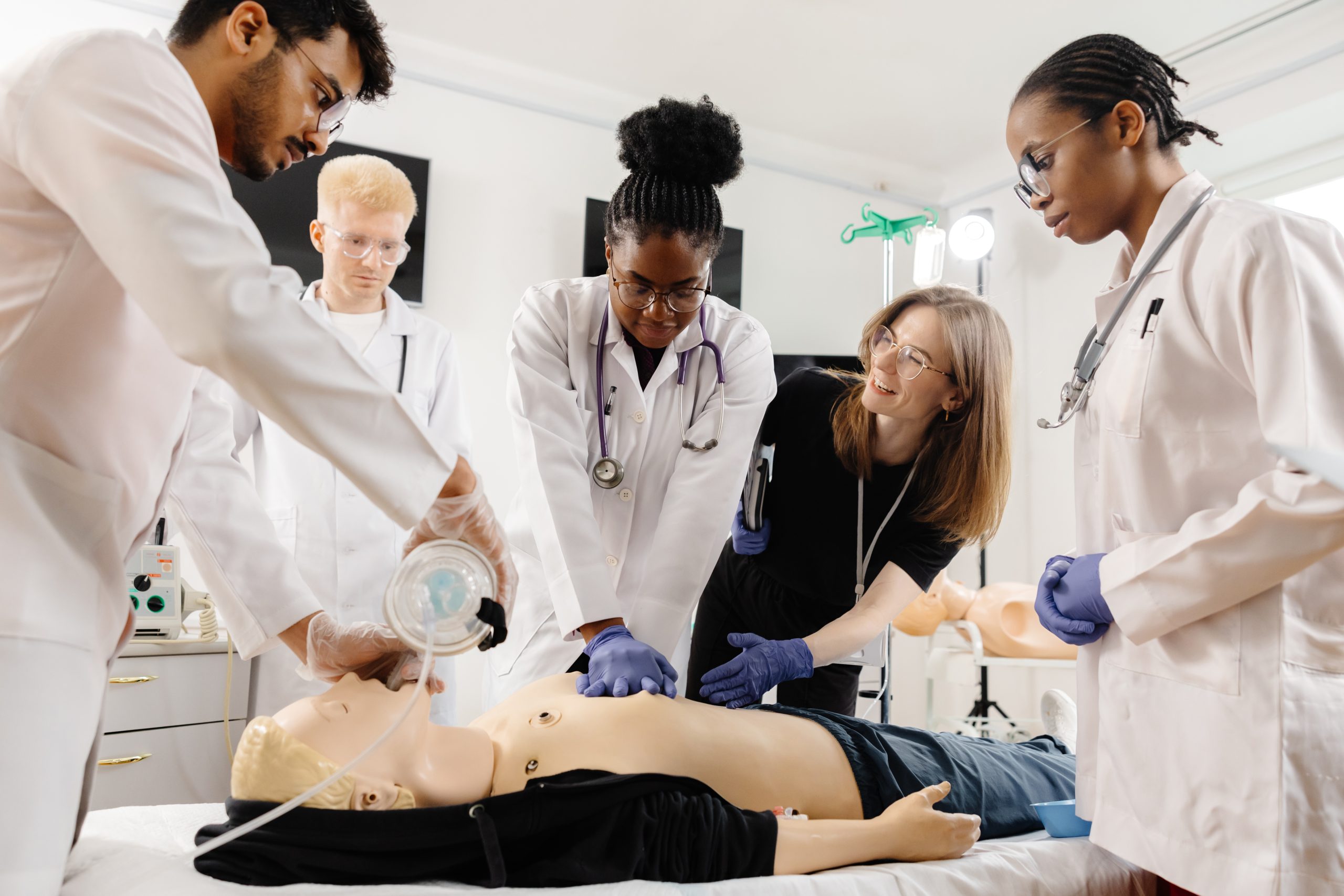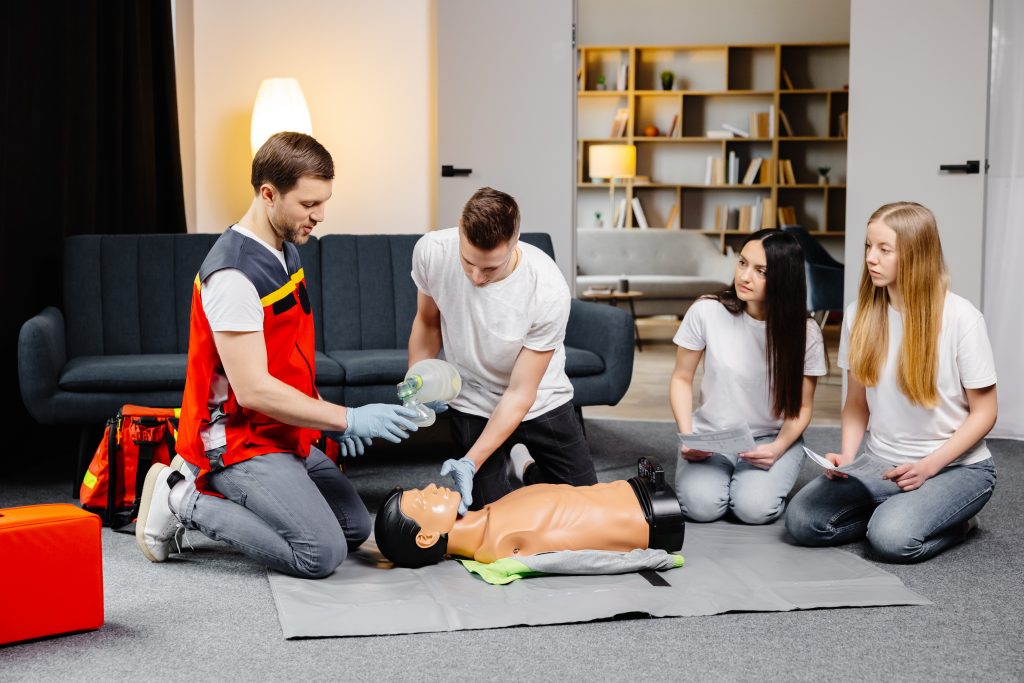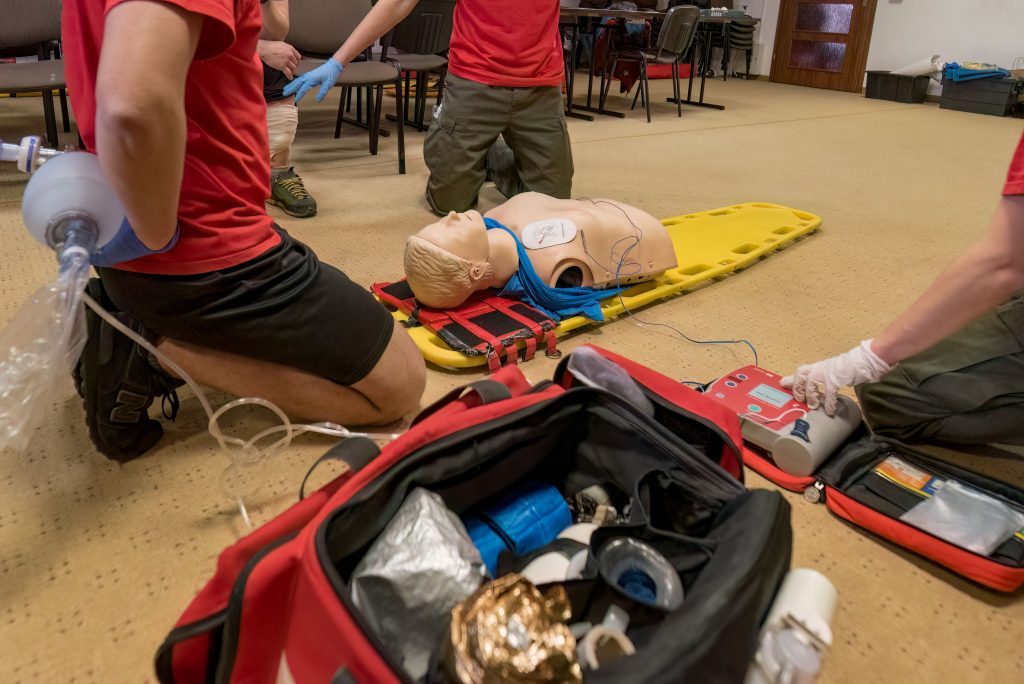
Stepping into the bustling healthcare environment of Baltimore, whether you’re starting a new nursing position at a major medical center or volunteering as an EMT, one requirement is non-negotiable: cardiopulmonary resuscitation (CPR) certification. However, the requirement is often more specific than simply “CPR Certified.” For most professional roles in the city’s robust medical landscape, the mandate explicitly calls for Basic Life Support (BLS) certification, and critically, specifies the provider: the American Heart Association (AHA).
Why does the choice between the American Heart Association and the American Red Cross matter so profoundly in a city known for medical excellence like Baltimore? While both organizations are highly respected, and both ultimately teach life-saving skills, they cater to fundamentally different audiences and uphold distinct standards, especially when lives in a clinical setting are on the line. The difference boils down to science, specialization, and the rigorous expectations of professional healthcare. Baltimore’s major employers, from large university hospitals to specialized clinics, view AHA BLS not just as a certification, but as the benchmark of professional competency and alignment with the most current evidence-based resuscitation guidelines.
This blog post will delve into the core reasons behind this preference, explaining why the AHA BLS certification is the necessary credential for anyone serious about a career in Baltimore’s demanding and life-saving healthcare sector. Understanding this distinction is the first critical step toward securing your professional future in the Charm City medical community.
Why is AHA BLS Considered the Gold Standard in Professional Healthcare?
Why do institutions in Baltimore, and across the nation, lean on the AHA as the definitive source for life support training? The preference stems directly from the American Heart Association’s foundational role as the global leader in resuscitation science and research. The AHA doesn’t just teach the guidelines; it writes them.
The AHA is the key partner in the International Liaison Committee on Resuscitation (ILCOR), which sets the comprehensive, global, evidence-based guidelines for emergency cardiovascular care (ECC). Every five years, ILCOR, with the AHA as a primary driver, reviews thousands of scientific papers to update the protocols for CPR, AED use, and advanced interventions. When you enroll in an AHA BLS course, you are learning techniques directly derived from the world’s most current and rigorous scientific consensus, often immediately after the science is published.
In a healthcare setting, this alignment with scientific research is not optional; it is paramount to patient safety and required by regulatory bodies. Hospitals, which are constantly striving for the best patient outcomes, must adhere to the latest, proven methodologies. The AHA BLS curriculum is specifically designed for the professional rescuer, ensuring that nurses, doctors, paramedics, and medical technicians receive training that is current, evidence-based, and focused on clinical application.
The structure of the AHA’s advanced coursework further solidifies its “gold standard” status. The AHA created and governs the sequential pathway of life support training: Basic Life Support (BLS), Advanced Cardiovascular Life Support (ACLS), and Pediatric Advanced Life Support (PALS). This interconnected hierarchy ensures a consistent, standardized approach to emergency cardiac care across all levels of a hospital staff. For Baltimore healthcare employers, choosing AHA BLS means integrating their staff into a cohesive system of care, providing the assurance that their employees are trained using the exact same protocols that govern the entire medical chain of survival. This deep, scientific integration and commitment to being the source of the protocols is the first, most powerful reason for the employer preference.

How Does AHA BLS Rigor Prepare Professional Rescuers Better?
Beyond the source of the science, the actual training methodology and rigor of the AHA BLS course are what truly set it apart for professional rescuers. The environment and requirements of a hospital floor demand more than just conceptual knowledge; they require precision and consistency under pressure. The AHA BLS curriculum is specifically engineered to achieve this higher level of professional competency.
One clear indicator of this rigor is the difference in passing standards. While the American Red Cross Basic Life Support program often requires an 80% passing score on the written exam, the American Heart Association typically demands a minimum passing score of 84%. This higher threshold reflects the expectation that healthcare providers must master the content with greater detail and accuracy.
More importantly, the AHA places a strict emphasis on measurable, high-quality CPR performance. To objectively ensure skill mastery, the AHA mandates the use of specialized instrumented directive feedback devices during practice and testing for all adult CPR skills. These devices provide real-time, objective data on the depth, rate, and recoil of chest compressions. This is not simply a suggestion; it is a requirement built into the curriculum. This technological precision allows students to immediately self-correct their technique and ensures that instructors can objectively verify that every professional rescuer is capable of delivering high-quality, life-saving CPR, not just “good enough” CPR.
Furthermore, AHA BLS training is intensely focused on the team environment prevalent in hospital emergencies. While Red Cross training often centers on the lone lay rescuer, the AHA BLS course delves deeply into the dynamics of team resuscitation, covering topics like effective communication, roles during a code, and efficient turnover to advanced providers. For Baltimore’s healthcare systems, where cardiac arrests are managed by coordinated teams of nurses, respiratory therapists, and physicians, this team-based training is essential for fostering high-performance dynamics that minimize errors and maximize patient survival chances. The elevated standard for knowledge and the objective measurement of physical skills provide Baltimore employers with the certainty that an AHA-certified employee is ready for the clinical environment.
What is the Essential Difference Between AHA BLS and Standard CPR Certification?
The most common source of confusion for job applicants is misunderstanding the distinction between Basic Life Support (BLS) for Healthcare Providers and general CPR/AED certification designed for the lay public. While both teach life-saving compression and ventilation skills, the purpose, depth, and audience are entirely different.
The AHA BLS course is a specialized certification crafted for professionals who work in a medical environment and are expected to perform resuscitation frequently and in conjunction with other trained individuals. The curriculum covers several advanced professional topics rarely addressed in general CPR courses:
- Two-Rescuer CPR: BLS emphasizes effective, two-person resuscitation dynamics, including coordinated switching of roles to minimize interruptions in chest compressions.
- Use of Barrier Devices and Advanced Airways: BLS training includes instruction on using a bag-mask device (BVM) and managing resuscitation efforts around advanced airways (like ET tubes), skills critical for healthcare personnel.
- Specific Adult, Child, and Infant Protocols: While standard CPR covers age groups, BLS provides nuanced, specific protocols for the professional management of cardiac arrest in every age bracket, ensuring readiness for clinical emergencies across all hospital units.
- Rapid Assessment: BLS includes training on the rapid and accurate assessment of a patient’s condition, enabling healthcare workers to quickly determine the correct intervention based on the American Heart Association’s Chain of Survival.
In contrast, a standard Red Cross Adult and Pediatric First Aid/CPR/AED course is primarily focused on the lay rescuer, a teacher, coach, parent, or office worker, who might encounter an emergency outside of a clinical setting. While incredibly valuable for the community, this type of certification generally does not include the depth of team dynamics, advanced airway management, or specific professional protocols required by Baltimore hospitals. When a job description asks for BLS, it is asking for the higher level of skill and knowledge offered by the American Heart Association, ensuring the applicant possesses the necessary clinical competencies for a professional medical environment.
Do Baltimore Healthcare Employers Truly Prefer One Certification Over the Other?
The preference for AHA BLS among Baltimore’s extensive network of healthcare employers is not just a trend; it is deeply embedded in institutional policy and driven by accreditation requirements. Major hospitals and clinical systems in the area have formalized their preference because the American Heart Association’s curriculum directly supports their institutional goals of patient safety and regulatory compliance.
For large teaching hospitals and medical centers, adherence to the latest national guidelines from bodies like The Joint Commission or the Centers for Medicare and Medicaid Services (CMS) is mandatory. Since the AHA is the authoritative source for the national resuscitation guidelines, requiring AHA BLS certification simplifies compliance and reduces institutional liability. Employers know that an AHA eCard guarantees that the employee was trained to the current, highest clinical standard.
If a healthcare professional presents a certification other than AHA BLS, even an equivalent BLS course from another reputable provider, they often run into administrative roadblocks. The employer’s human resources, credentialing, or clinical education departments may require the employee to:
- Obtain a letter of equivalency from the other provider, often leading to delays.
- Take an internal challenge test to prove skill and knowledge mastery.
- Complete a full AHA BLS course anyway, at the employee’s expense, to meet the strict internal policy.
The preference is also logistical. AHA BLS is built to integrate with the advanced AHA courses like ACLS and PALS, which are required for critical care, emergency department, and intensive care unit staff. By mandating AHA BLS from the start, Baltimore employers ensure that their high-level staff are seamlessly transitioned into these advanced training programs without any curriculum gaps. For the busy medical staff recruiter in Baltimore, the AHA eCard is a universal, trusted stamp of approval that guarantees the candidate meets the foundational professional competency required to step onto the floor and immediately contribute to high-quality patient care.

What Career Implications Does the Right Certification Have in Baltimore?
Choosing the correct certification is a strategic career decision that impacts everything from job eligibility and licensing renewal to future advancement opportunities in the Baltimore healthcare market. Possessing the AHA BLS certification signals a serious commitment to professional standards that can directly influence your career trajectory.
The most immediate implication is job eligibility. If a job listing for an RN, CNA, or medical assistant in Baltimore explicitly requires “AHA BLS,” submitting a resume with a different credential, even if theoretically equivalent, often leads to the application being filtered out. Using the preferred certification ensures your resume passes the initial screening, opening the door to the interview process.
Furthermore, the AHA BLS certification is universally valid for a full two years, which is a significant logistical benefit for working professionals. While the American Red Cross Basic Life Support certification is also valid for two years, many of their other, more general CPR/AED certifications can sometimes require yearly renewal. For healthcare providers, having a consistent two-year renewal cycle for all their life support certifications (BLS, ACLS, PALS) simplifies tracking and compliance.
Crucially, the AHA BLS course is the necessary first step on the professional resuscitation ladder. If your career path in Baltimore involves advancing to high-acuity areas, such as the Emergency Department at the University of Maryland Medical Center or the Cardiac ICU at Johns Hopkins, you will eventually need to complete the following AHA courses:
- ACLS (Advanced Cardiovascular Life Support): Required for professionals who manage cardiac arrest and other cardiopulmonary emergencies in adult patients.
- PALS (Pediatric Advanced Life Support): Required for professionals who manage emergencies in infants and children.
The foundational knowledge and protocols learned in AHA BLS are the prerequisites for these advanced courses. Training with the AHA from the beginning ensures a smooth, continuous educational path, proving to employers that you are prepared for the rigorous academic and clinical demands of a specialized healthcare career in a major metropolitan medical hub like Baltimore. Choosing AHA BLS is not just about meeting a requirement; it is about investing in a career pathway built on the highest standards of clinical excellence.
Conclusion
The choice between the American Heart Association BLS and the American Red Cross is clear for healthcare professionals in Baltimore. While the Red Cross provides an invaluable service to the community through its general preparedness courses, the AHA BLS course stands alone as the recognized, science-backed professional standard for clinical settings. This preference by Baltimore’s leading healthcare employers is built on a foundation of scientific leadership, rigorous testing standards (like the required 84% passing score and feedback devices), and a curriculum tailored specifically for professional, team-based rescue.
If you are pursuing a job in a Baltimore hospital, clinic, or medical office, the AHA BLS certification is your passport to employment and professional advancement. It ensures that you are trained using the exact same protocols that govern every Code Blue situation in the country, demonstrating an immediate, verifiable commitment to high-quality patient care.
Don’t risk having your application stalled or being forced to re-certify after hire. Secure your future in Baltimore’s thriving healthcare industry by choosing the proven path.
Ready to get certified with the American Heart Association BLS course that Baltimore employers prefer?
Contact CPR Classes Near Me today to find a high-quality, professional AHA-certified class in your area and take the definitive step toward saving lives with confidence.
Frequently Asked Questions AHA BLS Certifications for Baltimore Healthcare Employees
1. Why do I need BLS (Basic Life Support) instead of just a standard CPR certification for my healthcare job in Baltimore?
Answer: You need BLS because it is a higher level of certification designed specifically for healthcare professionals and professional rescuers. Standard CPR is primarily for laypersons. The AHA BLS curriculum includes professional-grade skills that are critical in a clinical setting, such as two-rescuer team dynamics, the use of a bag-mask device (BVM) for ventilation, and specific protocols for managing cardiac arrest and respiratory emergencies in a coordinated, hospital environment. Baltimore healthcare employers mandate BLS to ensure their staff possesses these advanced, clinical competencies, which are essential for high-quality patient outcomes.
2. How often do I have to renew my American Heart Association (AHA) BLS certification?
Answer: The American Heart Association BLS for Healthcare Providers certification is valid for a consistent period of two years. This two-year validity applies to almost all AHA professional courses, including ACLS and PALS. This standardized renewal cycle is beneficial for busy healthcare professionals as it simplifies credential tracking and maintenance, ensuring they remain current with the latest AHA resuscitation guidelines without excessive annual renewal requirements.
3. Is the American Red Cross BLS certification equivalent to the American Heart Association BLS certification in Baltimore hospitals?
Answer: While the core scientific principles taught by both organizations are aligned with ILCOR guidelines, the American Heart Association (AHA) BLS certification is often the preferred and explicitly required credential by Baltimore hospitals. The AHA holds a stronger reputation as the source of the resuscitation guidelines and enforces a higher standard of rigor, including an 84% passing score and the mandatory use of instrumented feedback devices during skills testing. If an employer’s policy requires “AHA BLS,” submitting a Red Cross certification, even if technically equivalent, may lead to administrative delays, a requirement to pass a challenge exam, or even a mandate to take the AHA course.
4. Are the training techniques different between AHA BLS and Red Cross?
Answer: The core life-saving techniques (compression rate, depth, and breath-to-compression ratio) are fundamentally the same because both organizations adhere to the international ILCOR guidelines. However, the training focus differs. AHA BLS training is geared toward precision, evidence-based data, and team scenarios, often requiring objective measurement of skills using feedback manikins. Red Cross courses are often more focused on broad accessibility, practical application, and user-friendly, interactive learning for a wider audience, including the lay public. For a professional medical role, the AHA’s emphasis on measured precision is the key differentiator.
5. Does choosing AHA BLS help me if I want to get my ACLS or PALS later?
Answer: Absolutely, yes. The AHA BLS course is the essential prerequisite and foundational stepping stone for all higher-level AHA courses. The American Heart Association created the comprehensive emergency cardiovascular care continuum, which includes: Basic Life Support (BLS), Advanced Cardiovascular Life Support (ACLS), and Pediatric Advanced Life Support (PALS). By starting with AHA BLS, you ensure a seamless transition and consistent knowledge base when you advance your training for critical care, emergency medicine, or pediatric roles, which often require ACLS or PALS certification.


Leave a Reply